Indianapolis has no reason to exist.
Most American cities grew organically by harbors, river oxbows, and Great Lakes—assembling around ports that made them hubs of commerce and connected them to the wider world. Indianapolis was plunked down on a flat, swampy, heavily forested tract of land to serve as a state capital. It was a city created by decree, on the reasoning it would be most geographically convenient for lawmakers from across the far reaches of Indiana.
A downtown canal dug in the hope of establishing the White River as a major trade route bankrupted the state government and spectacularly failed in its intended purpose. It turned out the river was too shallow for riverboats, and no one thought to check. The waterway is now flanked with condos for young professionals, lapped by purposeful joggers and occasionally enlivened by the warbling of a passing gondolier, but modern-day efforts to transform it into a lively strip like the San Antonio River Walk have yielded little progress.
Indianapolis has no reason to exist, and it sometimes feels like it.
Pierre L’Enfant apprentice Alexander Ralston platted Indianapolis to resemble Washington D.C. with a central circle and four diagonal avenues slicing through a grid. But outside the grand monuments and glittering skyscrapers of the original mile square, much of the city has the look and feel of generic suburbia that could be Anywhere, USA. There’s little population density, sprawling subdivisions of single-family homes, and a seemingly endless number of strip malls with Panera Breads and Noodles and Co. Everything is spread out. Everything is half an hour from everywhere else. There are neighborhoods where the most historic thing is an old Arby’s with a neon cowboy hat sign.
But before I disparage the city too much, let me give you a few fun facts. Indianapolis gave the world Wonder Bread, the Gatling Gun, Prozac and an open-wheel race that’s been declining in popularity for years. The greatest plaudits thrown its way are that “it’s a great place to raise a family” and “the downtown is walkable.”
Such an environment, however, has produced a number of literary luminaries, including Kurt Vonnegut Jr., two-time Pulitzer winner Booth Tarkington, Children’s Poet James Whitcomb Riley, the prolific post-war novelist Dan Wakefield, bestselling writer Meredith Nicholson and the staggeringly popular young adult author John Green. A talented crop of contemporary writers teaching at Butler University’s MFA in Creative Writing program include Allison Lynn, Dan Barden, Michael Dahlie, Justin Taylor, Ben Winters, and Lili Wright.
And the city celebrates its writers. A 38-foot-tall mural of Vonnegut towers over a trendy stretch of Massachusetts Avenue downtown. Bars throughout Indy are now serving “Cheers to Vonnegut” craft cocktails like So It Goes and Not Kilgore’s Drano to mark the 10th anniversary of his death. 2017 was named “The Year of Vonnegut” and will include many special events, such as tours of his childhood home, Vonnegut-themed plays at the IndyFringe Theater Festival and a three-day VonnegutFest with National Book Award winner and fellow veteran Brian Turner.
But the Slaughterhouse-Five author isn’t the only writer appreciated in the city. A park in Broad Ripple was named after Wakefield, who Vonnegut famously said would never be able to return to the city after how he portrayed it in the racy-for-its-time novel Going All the Way. Green drove the Grand Prix pace car before last year’s Indianapolis 500.
Here’s an itinerary of places to see on a literary tour of the Circle City:
Museums and such
The James Whitcomb Riley Museum Home at 528 Lockerbie Street is a 19th century Italianate house in the historic Lockerbie Square neighborhood, a charming, well-to-do enclave where “The Hoosier Poet” handed out candy to children on his ambling walks. Knowledgeable docents will guide you through the well-appointed Victorian home where Riley penned classics like Little Orphan Annie. Strolling through the stately, tree-lined neighborhood to get there is an experience all its own.
While in Lockerbie Square it’s worth stopping by the nearby Athenaeum, which Kurt Vonnegut Jr.’s architect grandfather Bernard Vonnegut built as Das Deutsche Haus in the 1890s. It was originally constructed as a gymnastics club and social club for Indy’s many German immigrants. Today the ornate architectural gem has The ArtSpace gallery on the second floor that displays contemporary artwork, as well as diverse tenants that include arts groups, the Young Actors Theatre, a YMCA and The Rathskeller German restaurant and beer hall. You can use your smartphone to go on a self-guided tour of the National Historic Landmark building.
The Kurt Vonnegut Memorial Library at 340 N. Senate Avenue is in the process of moving to a larger space at 646 Massachusetts Avenue after launching a successful crowdfunding campaign. The fascinating museum displays Vonnegut’s typewriter, Purple Heart and many whimsical doodles, such as an asterisk that depicts an asshole. It includes a replica of the book-lined study where he wrote, an art gallery and a sampling of rejection letters that may give any writer motivation to press on.
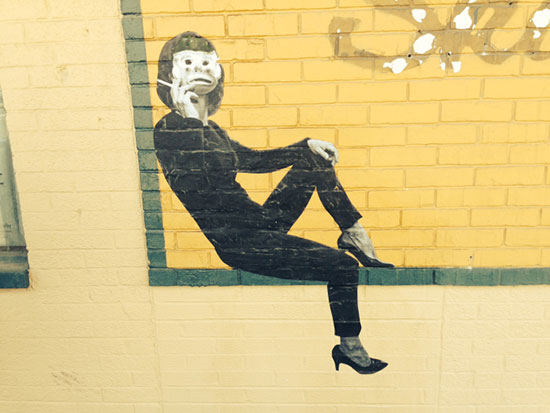
Fountain Square: Graffiti art in Indianapolis’s Fountain Square neighborhood, which is home to many artists and writers.
Where it all began
You’ll definitely want to drive by Shortridge High School, an august building at 3401 N Meridian Street that looks like it belongs on a college campus The school’s many notable alumni including Wakefield and Vonnegut, who first honed his writing chops there while working for the Shortridge Daily Echo, the first high school daily newspaper to be published in the United States. Meridian Street serves as Indianapolis’s main drag, and Shortridge sits on a stretch lined by many regal mid-rises and grand buildings.
Going All the Way
Wakefield’s most famous novel Going All the Way, which was adapted into an indie movie starring a then-young Ben Affleck, had many scenes set in the vintage Red Key Tavern, an old school dive at 5170 N. College Avenue where the legendary late owner banned many infractions like swearing, leaning back on one’s barstool and wearing one’s coat at the bar. The novel tracks two Korean War vets who return home and try to figure out what to do with the rest of their lives, while knocking back many beers in the vinyl booths of the neon lit hole-in-the-wall. It’s a cash-only watering hole with a row of model airplanes dangling overhead and a jukebox that would be familiar to a time traveler from the 1950s. The glowing sign outside has itself been a landmark in the South Broad Ripple neighborhood for decades.
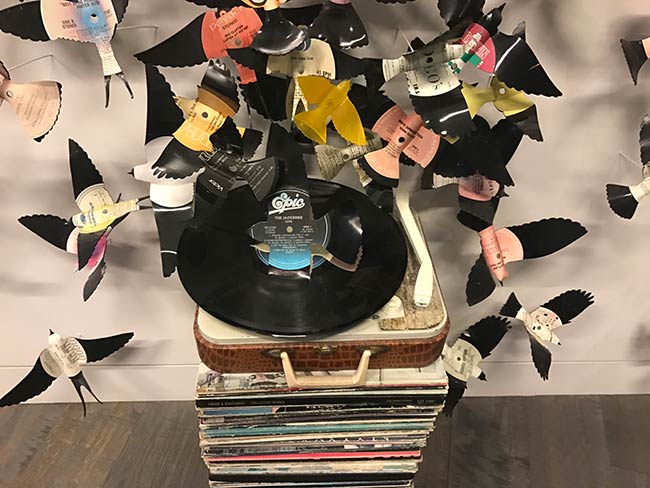
Alexander: Artist Paul Villinski uses vinyl records as his artistic medium in a piece at The Alexander art hotel.
Eats
Applebee’s was once considered the patron saint of Indianapolis, a town where chain restaurants long dominated; a place where shrimp cocktail was considered a culinary adventure. But times have changed, young chefs have garnered James Beard nominations, and places like Milktooth and Goose the Market have garnered acclaim from national magazines. For a literary-themed meal, you can’t go wrong at Bluebeard, a chic chef-driven eatery in the Holy Rosary neighborhood southeast of downtown named after the Vonnegut novel about an elderly painter’s ambitions to create art with meaning. Many cocktails bear literary names like Monkey House 2.0, The Pickwick Papers, Breakfast of Champions and Booth Tarkington. Bookshelves adorn the hip space, and the stylized menus include typewriters and quotes like “Write to please just one person.”
Woody’s Library Restaurant at 40 E. Main Street in the nearby suburb of Carmel is in a converted Andrew Carnegie Library, an ideal backdrop for any book lover. It has dishes like shaved leg of lamb with vanilla merlot demi glace, mint jelly, mushroom risotto and pea carrot saute, and is an upscale enough place where the hostess might ask you if you’re celebrating any special occasions when you come in.
Books
The Indianapolis Public Library Central Library at 40 E. St. Clair Street is a glistening cerulean repository of books that reaches for the heavens. A modern glass tower—appended in 2007—looms over the original classical, century-old Greek Doric library building. Sunlight pours into the glass-ceilinged atrium that’s held up by gracefully curving steel arches. The Special Collections room features the work of many local authors. To read in style, take the escalators up to the top floor, and camp out in a comfy leather chair while taking in one of the most sweeping views of the city’s skyline.
Indy is not a great city for bookstores, but a hidden treasure is Indy Reads Books at 911 Massachusetts Avenue. The independent not-for-profit bookstore hosts many live readings and every purchase there supports the Indy Reads adult literacy program. It’s gorgeously designed and houses an art gallery with rotating exhibits.
If you have a taste for craft beer, you’ll want to raise a pint at the straightforwardly named Books & Brews, a hybrid craft brewery and bookstore at 9402 Uptown Drive Suite 1400. It carries an array of used books, and the chill brewpub hosts gaming nights and pours beers like “A Portrait of a Stout as a Young Man” and “Nancy Brew and the Hoppy Boys.” Everything on the menu has a literary name, such as the “Naan-Fiction” section for flatbreads grilled on Indian naan bread.
Neighborhoods
Tarkington’s acclaimed The Magnificent Ambersons, which was adapted into an Orson Welles film, was set in the near-eastside Woodruff Place neighborhood. Once an extremely affluent area, it is now considered part of the inner city. Woodruff Place is listed on the National Register of Historic Places and has an opulent-looking fountain in every intersection. Streets are lined with stately magnolia trees and resplendent Victorian homes from the 19th century. Walking along them transports one to Tarkington’s tale of an aristocratic family’s decline amid the rise in industrialization.
The far-eastside Irvington neighborhood was named after the Legend of Sleepy Hollow author Washington Irving, and celebrates that heritage with the Historic Irvington Halloween Festival, billed as the oldest and largest Halloween street festival in the country. The artsy enclave is home to the cozy Bookmamas used book store at 9 S. Johnson Avenue, open mic poetry every Thursday at the 10 Johnson Avenue Coffeehouse and a few edgy theater troupes based out of the Irving Theater.
The Fault in Our Stars locales
Green’s heart-wrenching The Fault in Our Stars was a runaway bestseller with more than a million copies in print that was adapted into a hit movie in 2014. It’s easy to find many of the backdrops where the cancer-stricken young lovers Augustus and Hazel became smitten with each another. Visitors can clamber up and jump around on the “Funky Bones” skeleton in the 100 Acres sculpture park at the Indianapolis Museum of Art, at 4000 Michigan Road. The young adult book’s protagonists enjoyed a picnic on Dutch artist Joep van Lieshout’s highly interactive and fun skeletal sculpture that also pays homage to Indiana’s history as a home to Native American tribes.
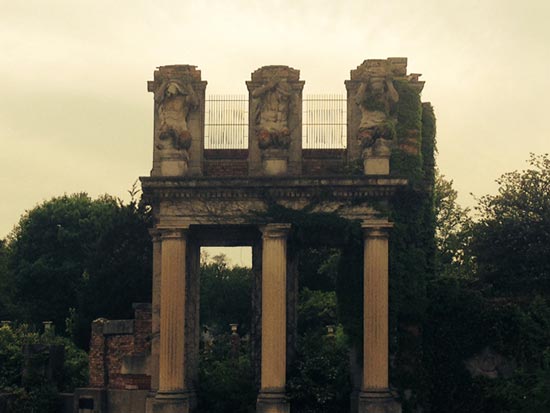
The Ruins at Holliday Park: Young adult author John Green featured The Ruins at Holliday Park in The Fault in Our Stars.
Another scenic backdrop in the novel is the Ruins at Holliday Park, 6363 Spring Mill Road. It’s a one-of-a-kind sculpture on the northside that repurposes the “Races of Man” facade of New York City’s St. Paul Building, which was razed in the 1950s. Indianapolis won an international competition to get the statues that adorned the skyscraper, and local artist Elmer Taflinger made them the focal point on an eccentric installation of fenced-off columns and other architectural salvage.
So . . .
Indy doesn’t have as vast and lively a lit scene as, say, Chicago, but The Geeky Press has regular readings as well as the weekly Downtown Writers Hack meetup. Universities like IUPUI and Butler bring in big names like Margaret Atwood, Jhumpa Lahiri and Junot Diaz. Indianapolis was once the hub of the Golden Age of Indiana Literature, when authors like Theodore Dreiser and Lew Wallace loomed over the literary landscape, and the Midwestern burgh remains home to many contemporary writers. To appreciate Indy’s rich literary history, it’s necessary to get out there and explore.
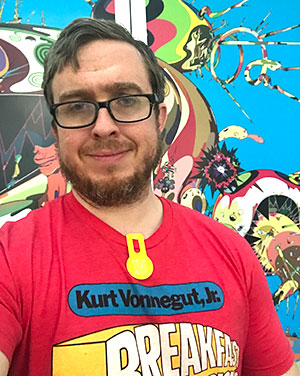
Joseph S. Pete is an award-winning journalist, an Iraq War veteran, an Indiana University graduate, a book reviewer, and a frequent guest on Lakeshore Public Radio. He was named the poet laureate of Chicago BaconFest 2016, a feat that Geoffrey Chaucer chump never accomplished. His work has appeared in Prairie Winds, The Grief Diaries, Dime Store Review, The Five-Two, Chicago Literati, Dogzplot, shufPoetry, The Roaring Muse, Blue Collar Review, Lumpen, McSweeney’s Internet Tendency, Pulp Modern, Zero Dark Thirty and elsewhere. He once Googled the Iowa Writers’ Workshop. True story, believe it or not.
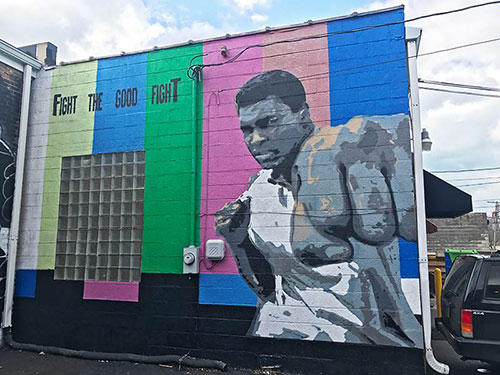
Photo of a place that inspires me to write: The lively graffiti murals in Gary’s Miller neighborhood have been a source of inspiration for me. I like to stroll and see the colorful street art to get my creative juices flowing and come up with new ideas.
5 Questions with Joseph S. Pete
TD: Tell us a little about this story? Where did the idea come from?
JSP: I lived in Indianapolis for a few years and always felt it punched above its weight in terms of literary output, but got little recognition from the wider literary world. The extent to which the city embraced literature impressed me, including the various tributes to Booth Tarkington, the multi-story mural of Kurt Vonnegut Jr. that towers over the trendy Mass Ave. theater and restaurant district, and the amply deserved rock star coronation of John Green. It inspired me to pen a guide to points of interest for visiting literary types.
TD: Who is your greatest writing influence?
JSP: Writers like George Saunders, Lori Moore, Lindy West and Kurt Vonnegut Jr. have had a significant influence upon me. Humor and satire speak to me in ways other genres don’t. They defend one against the slings and arrows of outrageous fortune, insulate people against the hostile indifference of the cosmos, and amuse. Though its virtues are multitudinous, what is literature if not a diversion?
TD: What is your favorite place to write and why?
JSP: As a working journalist, I’ve written in the halls of Congress, McDonald’s restaurants just off the interstate, grand conventions centers, countless coffee shops, the press box of the Indianapolis Motor Speedway, the press room of Assembly Hall and in my cramped car with a skittish WiFi connection through my iPhone that could die at any minute. I will write anywhere and everywhere, but my favorite place other than my desk in the newsroom is probably just my couch, since it’s where I’ve been most productive and prolific.
TD: Favorite word?
JSP: For the moment desuetude, since it’s poetic and aptly describes the condition of my hometown in the Rust Belt.
TD: Do you have a reading ritual?
JSP: I read anywhere and everywhere. I have multiple poetry and news apps on my phone. Since high school, I have read books while walking, ignoring whether others deem this eccentric. I always have a book in a pocket and a book or print publication in hand to fill any amount of dead time, however fleeting, with words, such as if a dinner companion has to excuse themselves briefly to use the restroom. An ex once broke up with me because I brought a library book into a screening of the movie “Inception.” I don’t care; I read whenever possible to feed my brain and nourish my work as a writer.

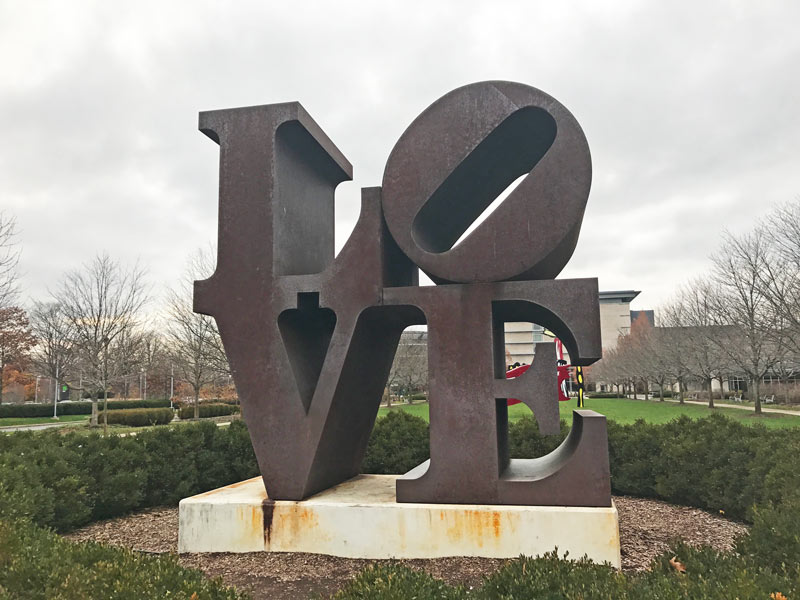

COMMENTS ARE OFF THIS POST